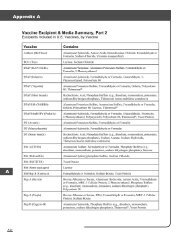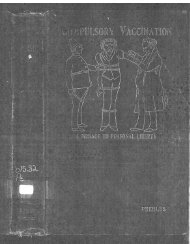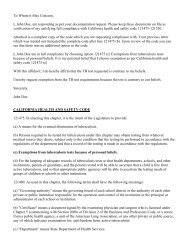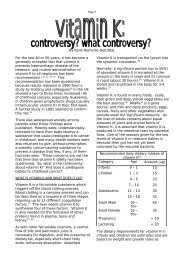Vitamin K Deficiency Disease
Vitamin K Deficiency Disease
Vitamin K Deficiency Disease
Create successful ePaper yourself
Turn your PDF publications into a flip-book with our unique Google optimized e-Paper software.
Journal of Orthomolecular Medicine Vol. 23, No. 1, 2008Postmortem FindingsThe autopsy findings confirmedwhat had already been observed clinicallyand a diagnosis of Shaken BabySyndrome was made.ResultsBesides a diagnosis of non-accidentalinjury or Shaken Baby Syndrome the childrenreported here have in common:1. Evidence of intra-cranial bleeding2. Evidence of fractures3. Prolongation of the prothrombin time4. Normal partial thrombplastin time5. Normal or raised platelet counts6.“Herald” bleeds – navel, urine, bruise7. No family history of bleeding or consanguinity.In no instance was there evidence ofdisseminated intravascular coagulation(DIC). Thrombocytopenia, microthrombiin the small blood vessels and thrombiin midsize and large arteries and veinswhich are markers of DIC were not recorded.Although congenital deficienciesof the coagulation factors are known tooccur they are rare and most would bedetected by prolongation of the partialthromboplastin time and by the familyhistory. It is clear that the finding of aprolonged prothrombin time is thus mostprobably due to a deficiency of vitaminK. An associated deficiency of vitaminC cannot be excluded particularly inCase 3 in which there was evidence ofmalabsorption or malnutrition.Just 50% of the normal concentrationof prothrombin is sufficient to produce anormal PT. 25 Prolongation of the PT, evenslightly, as in Case 3, is therefore evidenceof advanced vitamin K deficiency.In addition to a prolongation of theprothrombin time Case 2 showed significantabnormalities in the Transaminaselevels and is possibly an exampleof the neonatal hepatitis syndrome inwhich one expects malabsorption ofvitamin K. 26DiscussionThe blood coagulation proteins FactorsII, VII, IX and X and the bone formingproteins osteocalcin and matrix Glaprotein, to be functionally active, must becarboxylated by the vitamin K dependentenzyme g-glutamyl carboxylase. This actionconverts the glutamic acid residues of theseproteins to g-carboxyglutamic acid whichis a calcium binding amino acid requiredfor the function of vitamin K dependentproteins. 23 In the case of the coagulationproteins this function is the formation ofa blood clot and the prevention of bleedingwhile osteocalcin and matrix Gla proteinensure mineralization and strengtheningof bone and the prevention of pathologicalfractures.The infant’s vitamin K comes partlyfrom the mother via the placenta initiallyand from the breast milk later. It alsocomes partly from bacterial fermentationin the gut which in the first few days oflife is sterile. If the child develops diarrhea,as did the child in case 3, this source ofvitamin K is reduced or lost.Malabsorption of vitamin K in childrenmay be the result of a variety ofcauses 27 and antibiotic therapy may alsolead to vitamin deficiency by destroyingthe vitamin K forming bacteria in the gut. 28It is these children that are vulnerable tobleeding and pathological fractures andwho should be carefully investigated foran alternative explanation of the findingshitherto attributed to non-accidental injuryor to the Shaken Baby Syndrome. Bothvitamin K and C are intimately connectedwith the maintenance of the integrity ofbone and hemostasis and both are subjectto malabsorption.The children described here wereknown to have been given vitamin K atbirth as recommended but it is obviousfrom the prolonged prothrombin timethat it was not sufficient to sustain normalhealth and von Kries 29 has pointed out thatthe failure rate is about 0.25 per 100,000.18Innis.indd 42/18/08 3:46:38 PM




![Murder Inc. [polio/murder.pdf]](https://img.yumpu.com/36142565/1/163x260/murder-inc-polio-murderpdf.jpg?quality=85)







